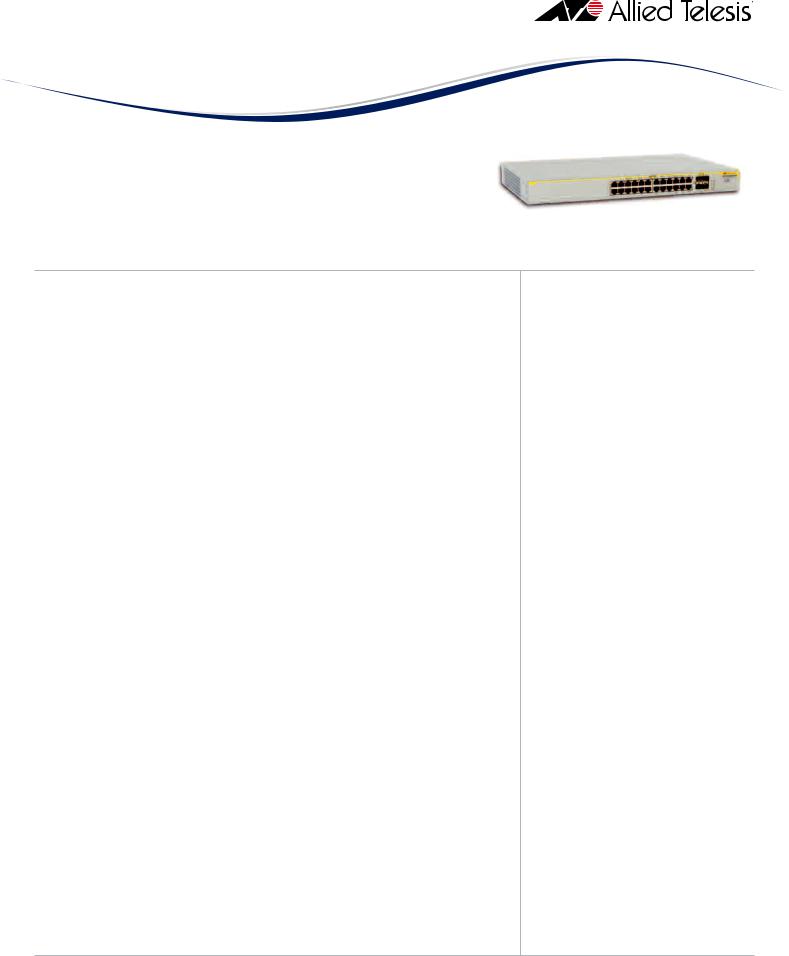Allied Telesis AT-8000GS-24POE User Manual

Datasheet | Switches
AT-8000GS/24POE
Layer 2 Stackable Gigabit Power over Ethernet Switch
AT-8000GS/24POE
24 port stackable 10/100/1000T Power over Ethernet Layer 2 switch with 4 standby SFP bays (unpopulated)
Overview
One of a series of high performance Gigabit Ethernet stackable switches from Allied Telesis, the AT-8000GS/24POE provides high performance Layer 2 switching in an affordable fixed configuration platform combined with Power over Ethernet for edge devices such as IEEE 802.11n access points, IP phones or IP cameras.This switch offers 24 10/100/1000 ports, with four combo 1Gbps SFP slots. Two integrated stacking connectors deliver a total of 20Gbps stacking bandwidth.The stacking capability integrated into this platform is configured as a resilient ring topology designed to provide high reliability and simplified management for higher port density applications. Support for jumbo Ethernet frames enables higher throughput of time sensitive data.
Ideal Branch Office and Wiring Closet Connectivity Where Power over Gigabit Ethernet is Needed
Powerful line rate performance and stackability make this switch ideal for branch offices or the wiring closet of larger offices.The state-of-the art QoS capability of this product ensures reliable delivery of advanced network services such as voice while effectively controlling the continually increasing traffic needs found in today’s networks.
Easy Access Networking
Featuring an industry standard CLI and Allied Telesis’ intuitive yet fully featured Web interface the advanced features of the AT-8000GS/24POE are accessible to a wide range of system administrators.The well known CLI and Web interfaces significantly reduce learning time and minimize the cost of deployment.
Secure Management
Only authorized administrators can access the management interface of the 8000GS series. Protocols such as SSL, SSH and SNMPv3 facilitate this protection of your network with local or remote connections.
Securing the Network Edge
To ensure the protection of your data, it is important to control access to your network. Protocols such as IEEE 802.1x port-based authentication guarantee that only known users are connected to the network. Unknown users who physically connect can be isolated to a pre-determined part of your network offering guests such benefits as Internet access while ensuring the integrity of your private network data.
Key Features
Easy,Well Known Management
•Industry standard CLI
•Simple intuitive, full featured Allied Telesis Web Interface
•Secure encrypted Web and CLI management with SSHv2 and SSL
•Two levels access privileges
•SNMP
Power over Ethernet
•Provides standards-based IEEE 802.3af
•Power over Ethernet to all 24 10/100/1000 ports
•Support for up to 18 class 2 powered devices at
7.3watts
•Support for up to 9 class 3 powered devices at
15.4watts
Affordable Truly Stackable 10/100/1000
Switching Platform
•Single IP address stack management
•20Gig resilient ring stacking architecture
•Across stack link aggregation
•Across stack VLAN configuration
•Across stack port mirroring
•Redundant standby stack master
All the QoS Needed in the Wiring Closet for Today’s Voice and Data Networking
•Eight priorities assigned to four queues
•IEEE 802.1p for Layer 2 QoS
•DSCP (DiffServ) for Layer 3 QoS
•IEEE 802.1p to DSCP remarking traffic ready for transport to the Layer 3 core of the network
•Layer 2 and Layer 3 Access Control Lists (ACL)
Securing the Network at its Most
Vulnerable Point
•IEEE 802.1x and RADIUS network login: for advanced control of user authentication and accountability
•Guest VLAN: to ensure visitors or unauthorized users connect only to services defined by IT. E.g. Internet
•TACACS+: for ease of management security administration
•Layer 2 and Layer 3 Access Control Lists (ACL)
•Port MAC Address security options
Allied Telesis |
www.alliedtelesis.com |

AT-8000GS/24POE | Layer 2 Stackable Gigabit Power over Ethernet Switch
Access Control Lists (ACLs)
Access Control Lists enable inspection of incoming frames and classify them based on various criteria. Specific actions can then be applied to these frames in order to more effectively manage the network traffic. Typically ACLs are used as a security mechanism, either permitting or denying entry (hence the name Access Control) for frames in a group, but can also be applied to QoS.
Supported ACL types are:
•IP ACLs – applicable to IP packet type. All classification fields are related to IP packets.
•MAC ACLs – classification fields are based on Layer 2 fields.
Technical Specifications
System Configuration
Dimensions |
44cm x 25.7cm x 4.32cm |
(W x D x H) |
(17.32” x 10.16” x 1.7”) |
Weight |
3.50kg (7.71lb) |
Mounting |
19” rack-mountable hardware |
|
included |
System Capacity
128MB RAM
16MB flash memory Up to 4,096 VLAN ID 8,000 MAC address
Performance
Wirespeed switching on all Ethernet ports for all packet sizes including jumbo frames up to 10Kbytes
Throughput up to |
50.6Mpps |
Switching capacity |
68Gbps |
Switch fabric speed |
88Gbps |
Port speed: |
|
10/100TX |
RJ-45 |
10/100/1000T |
RJ-45 |
1000SX, 1000LX |
SFP slot |
Console RS232 |
RJ-45 connector |
Interface Standards
IEEE 802.3 |
10T and 10FL |
|
IEEE 802.3u |
100TX |
|
IEEE |
802.3z |
1000SX |
IEEE 802.3ab |
1000T |
|
General Standards |
||
IEEE |
802.1D |
Bridging |
IEEE |
802.3x |
BackPressure/flow control |
Redundancy Standards |
||
IEEE |
802.1D |
Spanning-Tree Protocol with optional |
|
|
fast link capability |
IEEE |
802.1W |
Rapid Spanning-Tree |
IEEE |
802.1s |
Multiple Spanning-Tree |
IEEE |
802.3ad |
LACP link aggregation |
|
|
(with up to eight members per |
|
|
group and up to eight groups per |
|
|
device) |
Static |
port trunk |
|
Quality of Services (QoS)
QoS in Layer 2 (IEEE 802.1p compliant Class of Service)
Traffic prioritization using IEEE 802.1p, ToS, DSCP fields Map IEEE 802.1p priorities to CoS queues to prioritize
traffic at egress
Strict scheduling and weighted round robin
VLANs
IEEE 802.1Q VLAN tagging
Up to 256 active VLANs
Port-based VLANs
MAC-based VLANs
Private VLANs
GARP VLAN Registration Protocol (GVRP)
Multicast Standards |
|
|||
RFC |
1112 |
IGMP |
snooping |
(ver. 1) |
RFC |
2236 |
IGMP |
snooping |
(ver. 2) |
RFC |
3376 |
IGMP |
snooping |
(ver. 3) |
RFC |
3376 |
IGMP |
querier |
|
Management and Monitoring
WEB, CLI, Telnet, SSH, serial console port
RFC 1157 |
SNMPv1/v2c |
||
RFC 2570 |
SNMPv3 |
|
|
RFC |
1213 |
MIB-II |
|
RFC |
1573 |
Evolution of MIB-II |
|
RFC 1215 |
TRAP MIB |
||
RFC 1493 |
Bridge MIB |
||
RFC |
2863 |
Interfaces |
group MIB |
RFC |
1643 |
Ethernet |
like MIB |
RFC 1757 |
RMON 4 groups: |
||
|
|
Stats, History, Alarms, Events |
|
RFC 2674 |
IEEE 802.1Q MIB |
||
RFC 1866 |
HTML |
|
|
RFC 2068 |
HTTP |
|
|
RFC |
854 |
Telnet |
|
RFC 783 |
TFTP |
|
|
IP address |
allocation |
|
|
RFC |
951/ RFC 1542 |
BootP/ DHCP manual |
|
RFC |
2030 |
SNTP, Simple |
Network Time Protocol |
Syslog event
Dual software images
Stacking:
Up to six units with a mix of AT-8000GS/24, AT-8000GS/24POE and AT-8000GS/48 can be stacked together in any combination
Single system appearance Single IP management Backup master
Redundant ring stacking topology with 20Gbps performance
Link |
aggregation/trunking across stack |
|
Port |
mirroring across stack |
|
VLAN across |
stack |
|
Security |
||
Management |
security: username and |
|
password |
protection |
|
SSHv2 for Telnet management |
||
SSLv3 for Web management |
||
RFC 1492 |
TACACS+ |
|
RFC |
2618 |
RADIUS authentication |
RFC |
2865 |
IEEE 802.1x port-based |
|
|
network access control |
MAC-based network access control
Guest VLANs
ACL – Access Control Lists
Fault Protection
Broadcast storm control
Allied Telesis |
www.alliedtelesis.com |
